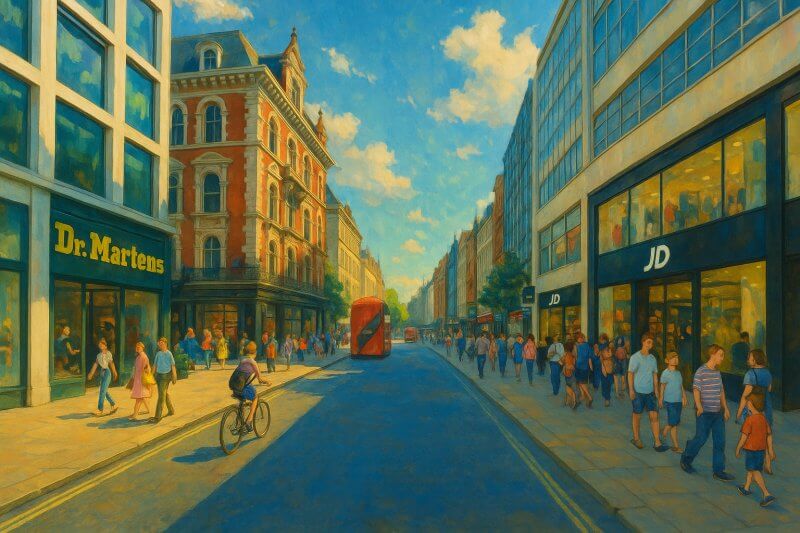
Oxford Street, London
Where Is Oxford Street?
Oxford Street is located in the heart of London’s West End, running through the City of Westminster. It stretches west to east from Marble Arch at the corner of Hyde Park to Tottenham Court Road near Centre Point and the eastern edge of Soho.It forms part of the A40, one of the principal routes into London from the west, and sits just north of Mayfair and south of Marylebone. The surrounding area is one of the busiest and most iconic parts of central London, with bustling streets and endless foot traffic.
How Long Is Oxford Street?
Oxford Street is approximately 1.2 miles (1.9 kilometres) long. While not especially lengthy by London standards, it is incredibly dense with shops, landmarks, and transit connections, making it one of the most important commercial thoroughfares in the capital.The History of Oxford Street
Oxford Street follows the route of a Roman road that connected Colchester to Hampshire. In the Middle Ages, it became known as Tyburn Road, named after the River Tyburn and the infamous Tyburn Gallows that stood near the present-day Marble Arch. It was a grim route that condemned prisoners walked from Newgate Prison to the place of execution.During the 18th century, as the surrounding fields gave way to elegant Georgian developments, the road began to be transformed into a more fashionable thoroughfare. By the late 1700s, the area was already gaining popularity among shoppers and residents.
How Did Oxford Street Get Its Name?
Oxford Street was officially named in the late 18th century, taking its name from the Earl of Oxford, whose estate owned a large part of the surrounding area. The name reflected a trend of giving prestigious and noble associations to newly fashionable areas of London.Previously known as Tyburn Road and then Uxbridge Road in parts, the name Oxford Street became fully established by the early 19th century as the area shifted towards commerce and elegance.
What Kind of Street Is Oxford Street?
Oxford Street is primarily a retail and commercial street, and arguably the most famous shopping street in Europe. It is home to over 300 shops, including flagship stores for some of the UK’s best-known brands.While its main function is retail, Oxford Street also hosts a variety of office spaces and restaurants. There is limited residential use along the street itself, though nearby side streets and areas like Fitzrovia and Marylebone are more residential in character.
Map of Oxford Street, London
Streets connecting to Oxford Street?
- Berners Street
- Berwick Street
- Binney Street
- Bird Street
- Chapel Place
- Charing Cross Road
- Davies Street
- Dering Street
- Duke Street
- Gee's Court
- Gilbert Street
- Great Chapel Street
- Great Portland Street
- Hanway Street
- Harewood Place
- Hills Place
- Holles Street
- James Street
- John Prince's Street
- Marble Arch
- Marylebone Lane
- New Bond Street
- Newman Street
- North Audley Street
- Old Cavendish Street
- Orchard Street
- Park Lane
- Park Street
- Poland Street
- Portman Street
- Rathbone Street
- Regent Street
- Soho Street
- Stratford Place
- Swallow Passage
- Tottenham Court Road
- Vere Street
- Wardour Street
- Wells Street
- Winsley Street
- Woodstock Street
Major Buildings on Oxford Street
Oxford Street features a variety of landmark buildings and flagship retail stores. Some notable examples include: West Side Highlights:- Marble Arch – A neoclassical triumphal arch, originally intended for Buckingham Palace, now situated at the western end of Oxford Street.
- Selfridges – Located near Bond Street Station, Selfridges is a Grade II* listed building and the second-largest department store in the UK after Harrods.
- Centre Point – A modernist skyscraper and prominent London landmark near Tottenham Court Road Station.
- Primark (East Store) – A popular multi-level flagship store at the junction of Oxford Street and Tottenham Court Road.

Painting of Oxford Street (View full-size image here)
Which Tube Stations Serve Oxford Street?
Oxford Street is extremely well served by the London Underground, with several stations directly along or adjacent to the street. These include:- Marble Arch – Central Line
- Bond Street – Central Line and Jubilee Line (also served by the Elizabeth Line)
- Oxford Circus – Central Line, Victoria Line, and Bakerloo Line
- Tottenham Court Road – Central Line and Northern Line (also served by the Elizabeth Line)
Fun Facts About Oxford Street
Oxford Street is full of fascinating trivia and historical tidbits. Here are a few that stand out:- Oxford Street welcomes around half a million visitors a day during peak periods, making it one of the busiest shopping streets in Europe.
- Selfridges was opened in 1909 by American retailer Harry Gordon Selfridge, introducing many modern retail concepts to the UK, including window displays and in-store experiences.
- During World War II, Oxford Street suffered significant damage from bombing raids but was quickly rebuilt in the post-war years as consumer culture boomed.
- Every year, Oxford Street famously lights up for Christmas with a festive light display, often switched on by celebrities and accompanied by live performances.
- Oxford Street once had a tramway system in the early 20th century and was a hub of London’s growing public transport network.
A Street That Symbolises London’s Retail Heart
Oxford Street is more than just a place to shop—it represents London’s commercial energy, fashion influence, and cosmopolitan spirit. With deep historical roots, royal connections, and ongoing modernisation, it remains a must-see destination for anyone exploring the capital.Whether you're in the market for a new wardrobe, a bit of history, or just want to experience the pulse of London's West End, Oxford Street delivers in grand style